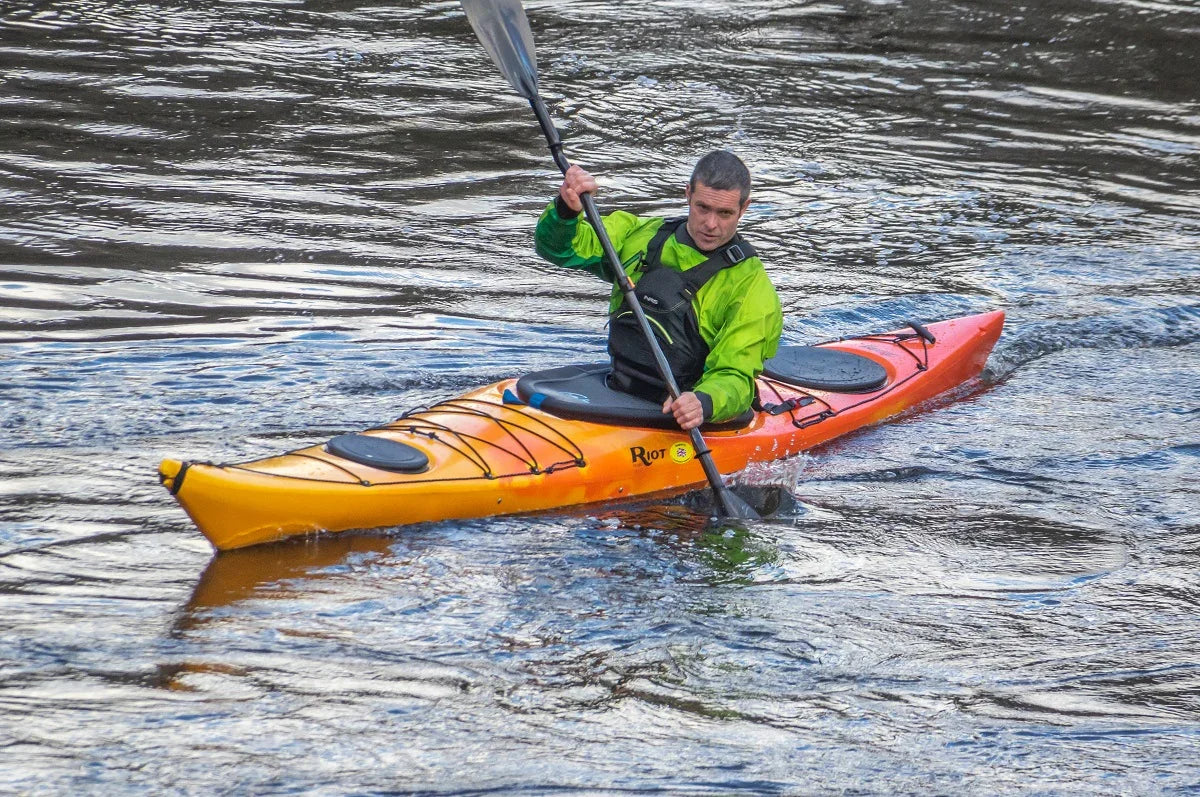Kayaking in Fall: Essential Preparation & Outfit Tips
Kayaking in fall offers a unique and refreshing experience. The crisp air and vibrant colors make it special.
As the leaves change and temperatures drop, kayaking in fall requires some preparation. You need to stay warm and safe on the water. This season brings its own set of challenges and beauty. Knowing what to wear and how to prepare can make your adventure more enjoyable.
From choosing the right gear to layering your clothes, each detail matters. This guide will help you get ready for your fall kayaking trip. Let’s dive into the essentials for a memorable and comfortable outing.
Choosing The Right Kayak
Kayaking in fall offers a unique and beautiful experience. The right kayak can make your adventure even better. Selecting the perfect kayak depends on several factors. Let’s explore the different types of kayaks and key features to consider.
Types Of Kayaks
Understanding the various types of kayaks can help you make an informed choice. Here are the main categories:
- Recreational Kayaks: Ideal for calm waters like lakes and slow-moving rivers. These kayaks are stable and easy to paddle.
- Touring Kayaks: Designed for longer trips on open water. They are faster and have more storage for gear.
- Whitewater Kayaks: Built to handle fast-moving, rough waters. These kayaks are shorter and more maneuverable.
- Inflatable Kayaks: Convenient and portable. They can be used in various water conditions.
- Tandem Kayaks: Meant for two people. These are great for family outings or paddling with a friend.
Features To Consider
When choosing a kayak, certain features can enhance your experience. Pay attention to the following:
| Feature | Why It Matters |
|---|---|
| Material | Durable materials like polyethylene are cost-effective. Composite materials are lighter but more expensive. |
| Weight | Lighter kayaks are easier to transport and handle. |
| Length | Longer kayaks are faster. Shorter ones are more maneuverable. |
| Width | Wider kayaks offer more stability but may be slower. |
| Storage | Consider how much gear you need to carry. Look for kayaks with ample storage space. |
These features can significantly affect your kayaking experience. Choose wisely to ensure a smooth and enjoyable adventure.
Safety Gear Essentials
Kayaking in the fall can be a thrilling adventure. The crisp air, colorful leaves, and peaceful waters provide a unique experience. But safety should always come first. Proper safety gear ensures a secure and enjoyable trip. This section will cover the essential safety gear needed for fall kayaking.
Life Jackets
A life jacket is a must-have for any kayaking trip. It keeps you afloat in case you fall into the water. Even strong swimmers need life jackets. Cold fall waters can cause muscle cramps and fatigue. Make sure the life jacket fits snugly and is Coast Guard approved. Choose a bright color for visibility. This helps others spot you easily in an emergency.
Helmets
Helmets protect your head from injuries. They are essential when kayaking in rocky areas. Falling or hitting your head on a rock can be dangerous. Wear a helmet that fits well and is designed for water sports. Helmets should be lightweight and comfortable. Check for adjustable straps for a secure fit. Remember, safety comes first.
Dressing For Fall Weather
Kayaking in the fall can be a magical experience. The crisp air, vibrant foliage, and tranquil waters create an unforgettable adventure. However, dressing appropriately for fall weather is essential to ensure comfort and safety.
Layering Techniques
Layering is crucial for fall kayaking. It helps regulate your body temperature and keeps you dry. Consider the following layering strategy:
- Base Layer: Start with a moisture-wicking base layer. This layer should fit snugly and keep you dry by wicking sweat away from your skin. Avoid cotton as it retains moisture.
- Insulating Layer: Add a warm, insulating layer. Choose materials like fleece or wool. This layer traps heat and keeps you warm.
- Outer Layer: Finish with a waterproof and windproof outer layer. This layer protects you from the elements, such as rain and wind.
Waterproof Clothing
Staying dry is vital for a comfortable kayaking experience. Invest in quality waterproof clothing to stay protected:
- Waterproof Jacket: Choose a breathable, waterproof jacket. It should have sealed seams to prevent water from seeping in.
- Waterproof Pants: Opt for waterproof pants with adjustable cuffs. They keep your legs dry and warm.
- Neoprene Gloves: Wear neoprene gloves to keep your hands warm and dry. They provide a good grip on the paddle.
- Waterproof Footwear: Select waterproof shoes or boots. They should have good traction and keep your feet dry.
With the right clothing, you can fully enjoy your fall kayaking adventure. Follow these tips to stay warm, dry, and comfortable on the water.

Credit: v.pinimg.com.gslb.pinterest.com
Packing The Necessary Equipment
Pack a dry bag with essentials like a waterproof jacket, extra layers, and a first aid kit. Bring a thermos with hot drinks to stay warm.
Kayaking in fall offers unique and breathtaking views. But the season also brings cooler temperatures and unpredictable weather. Packing the right equipment ensures you stay safe and enjoy your adventure. Here’s what you need to bring.Dry Bags
Dry bags are essential for keeping your belongings safe and dry. They come in various sizes to fit different items. Use small dry bags for electronics and personal items. Larger dry bags can store clothes and food. Ensure the bags are sealed properly. This prevents water from getting in. Label each bag for easy access.Navigation Tools
Navigation tools are crucial for kayaking in fall. Weather conditions can change quickly. A map and compass are basic tools every kayaker should have. A GPS device adds an extra layer of safety. It provides real-time location tracking. Keep your navigation tools in a waterproof case. This protects them from water damage. Remember to pack extra batteries for your devices. “`Planning Your Route
Kayaking in fall offers a unique and breathtaking experience. The vibrant colors of the leaves and the crisp air make for an unforgettable adventure. But before you hit the water, it’s important to plan your route. Proper planning ensures a safe and enjoyable trip. Let’s dive into the key aspects of planning your kayaking route.
Researching Locations
Start by researching popular kayaking spots in your area. Look for lakes, rivers, and coastal areas known for their fall beauty. Check if the location has any access points or launch sites. Make sure the water conditions are suitable for your skill level. Reading reviews from other kayakers can provide valuable insights. They often share tips and recommendations about the best routes and scenic spots.
Weather Considerations
Fall weather can be unpredictable. Always check the weather forecast before heading out. Look for clear skies and mild temperatures. Avoid days with high winds or heavy rain. Cold water and rough conditions can be dangerous. Dress appropriately for the weather. Layering is key to staying warm and comfortable. Wear moisture-wicking clothes and avoid cotton. Bring a waterproof jacket in case of rain.

Credit: www.canoe-shops.co.uk
Nutrition And Hydration
Kayaking in fall offers a unique experience with cooler weather and breathtaking scenery. It is essential to stay energized and hydrated throughout your journey. Proper nutrition and hydration are key to maintaining your stamina and ensuring an enjoyable trip. Let’s delve into some practical tips and recommendations.
Healthy Snacks
Bringing the right snacks can make a huge difference in your energy levels. Here are some healthy snack options:
- Granola bars: Easy to pack and provide quick energy.
- Nuts and seeds: High in protein and healthy fats.
- Fruits: Apples, bananas, and oranges are portable and nutritious.
- Trail mix: A combination of nuts, seeds, dried fruits, and dark chocolate.
Consider packing your snacks in waterproof containers to keep them dry and fresh.
Staying Hydrated
Hydration is crucial while kayaking. Dehydration can lead to fatigue and impaired judgment. Here are some tips to stay hydrated:
- Water bottles: Bring enough water for the duration of your trip. A good rule of thumb is at least 1 liter per hour.
- Electrolyte drinks: These can help replenish lost minerals and maintain your energy levels.
- Hydration packs: Hands-free hydration systems are convenient and ensure you drink regularly.
Remember to sip water frequently, even if you do not feel thirsty. Staying hydrated will keep you alert and improve your overall kayaking experience.
Maintaining Your Kayak
Keeping your kayak in good shape is crucial, especially in fall. As the weather changes, so do the conditions your kayak faces. Proper maintenance ensures a safe and enjoyable experience on the water. It also extends the life of your kayak.
Cleaning Tips
Clean your kayak after each use. Remove any leaves, dirt, or debris. Use mild soap and water to wash the surface. Rinse thoroughly to avoid soap residue. Dry it completely to prevent mold and mildew.
Pay attention to the nooks and crannies. These areas can trap dirt and moisture. A soft brush can help clean these spots. For stubborn stains, use a solution of vinegar and water.
Storage Solutions
Store your kayak in a cool, dry place. Avoid direct sunlight, as it can damage the material. Use a kayak cover for extra protection.
If you store your kayak indoors, keep it off the ground. A wall rack or ceiling hoist works well. These options save space and protect your kayak.
For outdoor storage, elevate your kayak. This keeps it away from moisture and pests. Secure it with straps to prevent it from falling or getting damaged.

Credit: v.pinimg.com.gslb.pinterest.com
Safety Precautions
Prepare for fall kayaking by wearing a wetsuit for warmth and a life jacket for safety. Check the weather forecast and water conditions before heading out.
Kayaking in the fall offers stunning views and serene waters. But safety is key. The weather can be unpredictable. Cold water and shorter days present unique challenges. Preparation is essential for an enjoyable trip.Emergency Procedures
Knowing emergency procedures can save lives. Learn basic first aid. Carry a first aid kit. Understand hypothermia symptoms and treatments. Always wear a life jacket. Practice self-rescue techniques. These steps increase your safety on the water.Communicating Plans
Always share your plans with someone. Inform a friend or family member about your route. Give them your expected return time. Use a GPS or a map. Carry a whistle or a signal mirror. These tools help rescuers find you. Also, consider using a waterproof phone case. This ensures you can call for help if needed. “`Frequently Asked Questions
What Should I Wear For Fall Kayaking?
Wear layered clothing, including a moisture-wicking base, insulating mid-layer, and waterproof outer shell. Don’t forget a hat and gloves.
How To Stay Warm While Kayaking In Fall?
Use insulated layers, waterproof gear, and bring a thermos with a hot drink. Keep moving to maintain body heat.
Is It Safe To Kayak In Fall?
Yes, if you prepare properly. Check weather, wear appropriate gear, and inform someone about your plans.
What Gear Is Essential For Fall Kayaking?
Essential gear includes a PFD, dry bag, waterproof clothing, kayak paddle, and safety equipment like a whistle and flashlight.
Conclusion
Kayaking in the fall offers a unique and peaceful experience. Proper preparation ensures safety and comfort. Dress in layers, choose the right gear, and check the weather. Staying warm and dry is key. Always inform someone about your trip plans.
Enjoy the stunning autumn scenery while paddling. Kayaking in fall can be memorable and fun. Stay safe and happy kayaking!



